
[dropcap]Jeow[/dropcap] is the Lao collective word for the ubiquitous and extremely delicious/flavourful and addictive sauce/relish that customarily accompanies Lao dishes and meals. From simple yet effective wet dipping sauces (such as a combination of fish sauce, chilies and lemon/lime juice) to more dry relish-style sauces such as jeow artichoke and jeow het (mushroom) – jeow are a tasty and clever culinary invention and prerequisite that have the power to transform a simple and plain dish/meal into a tasty delight.
One such relish-style Lao jeow that is a favourite to the Lao locals (and Lao population worldwide) and travellers/explorers alike is the classic sweet and spicy chili sauce/relish called jeow bong – the signature jeow/relish of Luang Prabang – the former royal capital and seat of government of the kingdom of Laos (before 1975).((1))
Luang Prabang is a UNESCO world heritage site, located in the north of Laos, nestled between mountains and along the Mekong River. It is an idyllic and picturesque city that is rich in culture, history and art. It epitomises the tranquil and peaceful small/rural city lifestyle that many people dream about. I’m coming over to visit soon Luang Prabang!
Gastronomically, Luang Prabang is the capital of Laos. The best cooks were hired by the King, including Phia Sing, who was the Royal Cook in the Royal Palace at Luang Prabang. Phia compiled a record of his culinary masterpieces which was reproduced in a book, titled “Traditional Recipes of Laos”, edited by Alan and Jennifer Davidson (Prospect Books, 1981). The book is available as two paperback editions, complete with an English translation and Phia’s original handwritten recipes. Phia’s classic Lao recipes continue their legacy in the region today and include dishes such “Or Lam Nok Kho” and “Sai Ua Moo” to name a few, and of course “Jaew Bong”.((2))


Jeow bong (also seen spelt as jaew bong (as mentioned above), cheo bong, etc. [it sounds a lot like “gel” – the stuff you put in your hair]) is made up of two separate words – “jeow” and “bong”.
Jeow as explained earlier, is a collective/all-encompassing word that refers to accompaniments in the form of sauces, dips and relishes. Bong means “pickled” – and although jeow bong is not literally a pickle, it does keep for a long time, just like pickles can – and this seems to be why it has this name.((5))
The trademark characteristics of jeow bong are its intense sweet and spicy aromatic/herbal flavours (from the chilies, garlic, galangal, shallots, etc.). Depending on the cook’s preference, the intensity of the chili heat can be customised to suit, but jeow bong is typically remembered/famed for its appetising spiciness. The spiciness seems to be perfectly enhanced/complimented by the sweetness – making you want to eat more. The taste of mild/neutral sticky rice and naturally sweet steamed veg such as Brassica balances the equation and mellows/tempers the heat/chili sensation well.
Besides its fiery/formidable, yet oh so inviting (varying shades of) red/orange colours – the other unique characteristic of jeow bong is its alluring “ohh-I-must-try-that” strips/strands of dried water buffalo skin or pork skin (which is what I used in this recipe). The shredded skin not only add visual appeal/intrigue, but also a wonderful slightly rubbery/tenon-y (but totally chewable) texture to the relish, making it a perfect blend/ingredient to the jeow bong!
Because of its distinctive flavour/properties (sweet and spicy – but not crazy spicy, mind you), a little of the jeow bong will go a long way. Often, only a smidgen of a smidgen (enough to dab/colour you rice or veg) is enough to give flavour and make you happy. Perhaps more, depending on your recipe. Jeow bong is a deliciously divine spicy candy-like relish/sauce that you’ll want to bottle and keep forever. It is perhaps similar to tum mark hoong (in terms of flavour sensation), but in a different outfit and without as many tears.
Jeow bong makes a excellent accompaniment to sticky rice and steamed or fresh veg. It also pairs perfectly with cooked/grilled meats. It is also enjoyed with kaipen – another Luang Prabang speciality – a snack made from river algae and sesame seeds – similar to nori sheets. If you prefer, you can also enjoy jeow bong as a relish/your new favourite hot sauce to have with your favourite dish/meal. Move over and make some room Sriracha!
There are several different recipes for jeow bong available online, including Phia’s original/documented recipe. The other recipes that I managed to find include (not in any particular order):
Phia Sing’s jaew bong recipe at Traditional Recipes of Laos.
Dorothy Culloty’s jeow bong recipe at Food From Northern Laos.
Lisa Featherby’s jaew bong recipe at Australian Gourmet Traveller.
Mark Busse’s jaew bong recipe at Foodists.
Sao Darly’s Aunt Kian’s jeow bong recipe at Sao Darly and YouTube.
Nye Noona’s Jeow Bong Throwdown at Nye Noona.
I’m sure there’s several other recipes/variations to jeow bong, including the one you’re about to learn about below! bigsmile All of the recipes above look and sound amazing, and I’m pretty sure they would accompany any Lao (or non-Lao dish/meal) perfectly!
With my recipe, I loosely based it on Phia’s original recipe, but have adapted/combined influence from the other recipes to it. This include using fried kaffir lime leaves, frying the ingredients in oil (resulting in a fabulous infused oil [similar to the gar gin sha oil and ginger and garlic chili oil recipes, and perfect for reservation]) instead of grilling/charring them, adding some fermented fish sauce (c’mon – this blog is called padaek for a reason), and some shrimp stock/liquid and infused oil to the mixture. You’ll learn more about my process as you view the photos.
In retrospect, I wish I had used some tamarind pulp in my recipe, as described in Lisa and Mark’s recipes/examples. The idea of tamarind in the jeow bong does sound interesting/delicious and I had some in the fridge but it was just another process to do, and making the jeow bong turned out to be a whole day’s event. I’ll remember it for next time. Funnilyenough, jeow bong might look like a simple sweet and spicy chili sauce/relish, but it ended up being a laborious and time-consuming effort (mainly from pounding and slicing the ingredients, not to mention frying, and taking hundreds of photos, lol).
Anyhow, without further ado, please enjoy the jeow bong recipe and photos below and I hope you’ll give this classic traditional Lao sweet and spicy chili sauce/relish a try/go. It really is magically delicious/saab! Five million stars!
Oh, before I go, here’s a quick Q&A about the jeow bong to help answer some questions that you might have. If you have other Qs, please feel free to leave a comment/let me know. Lar gon! That’s Lao for see you later alligator (or just “see you later” to be more precise). Remember that for me!
~
Q&A:
Q: So how did this recipe turn out for you Padaek?
A: OMG – I thought you wouldn’t ask! It turned out amazingly delicious! Sweet and spicy, herbal and slightly salty, savoury and umami rich moreishness – so so saaaaaaaaaaaaaaaaaab!!! bigsmile Surprisingly, this particular dish/recipe/rendition did not turn out as spicy as I had planned/hoped for (because I had a hiccup with the chili – you’ll find out below) but it was/is still very delicious indeed. Next time, I will add more chilies and/or use hotter chilies (seriously!). For me, personally, this jeow bong probably has the heat intensity of about 1 out of 10 on the Padaek chili heat scale. Nothing really, right?
Q: Why did you use three different types of chilies? Can I just use dried red chilies like normal people/the recipes above?
A: OK, smarty pants, to answer your question – I used 3 types of chilies because I burnt most of the dried red chilies (which I had initially planned to use, plus fresh red chilies for extra kick) when frying/taking photos of them. Are you happy now? Anyhow, yes – you can just use dried red chilies (the whole 100 grams) if you want. In fact, you can use what ever type of chilies you want, but Phia’s recipe does use dried red chili peppers, so you might want to use that if you want to stay true to his recipe. Next question.
Q: I can’t find French shallots to save my life. Can I use normal red shallots instead?
A: Of course you can. Yeah, French shallots sound pretty schmancy, but there’s been several times at the shops when the only way/word I could use to successfully describe small red shallots/onions was “French shallots”, so I listed them in the recipe to help make it easier for you to identify them, and also because the ones I used were French shallots. Asian shallots will work perfectly fine, so will eshallots, or any small red shallots/onions. You know what I’m talking about don’t you?
Q: I can’t find dried shrimp either, what can I do?
A: Haha – I don’t know, go and ask your mum. Just joking. bigsmile Many Thai/Vietnamese (and possibly other Asian grocery stores too should have dried shrimp for sale. If you can’t find them, just ask the friendly shop lady or gent for help. Dried shrimps (aka goong hang) are sometimes available in large boxes and are sold by required weight. They’re a tasty garnish/snack too so be careful to not eat too many of them, especially if you have an allergy for prawns/seafood. For this jeow bong recipe, remember to soak them in boiling/hot water first to soften/rehydrate them! Also, if you still can’t find dried shrimp, or want to try something different, perhaps you want to use fermented salted mackerel, as demonstrated in Lisa’s recipe above. I haven’t tried this before, so please let me know how it turned out, if you decide to give it a go!
Q: Oh, and the pork skin? Where can I get me some pork skin? Oh, how about water buffalo skin? Do you know where I can get some water buffalo skin from?
A: OK, calm down sweetheart/tiger. You can get pork skin from the same places as above. They’re usually kept in the fridge/cool room. The place I got mine from had them in 500g and 250g packets. I used 500g, but you really only need to use 250g for this recipe. Believe me, otherwise it will just be too much pork skin, unless you really like pork skin, in which case, go for it! Regarding the water buffalo skin – I have no idea where you can get them from in Australia, maybe a water buffalo farm from up north? Also, probably from Laos but that’s some serious dedication to fly to Laos just to buy water buffalo skin to make jeow bong with. If you do decide to though, or if you have any success in finding water buffalo skin here in Oz – please feel free let me know too! bigsmile
Q: Do you recommend frying the ingredients, instead of grilling/charring them like what Phia described in his recipe?
A: Yes, although it’s a personal choice, because I personally love the crunchy/nutty flavour of the ingredients when they’re fried, in particular the garlic and shallots! Also, you end up with the infused oil which you can store in a bottle and use as cologne – just joking! bigsmile Seriously though, the infused oil can be used for all sorts of culinary purposes – to dress salads, to fry with, etc. Also, I believe that when the ingredients are fried instead of grilled/charred, they become more crispy and brittle, making them a lot easier to pound with a mortar and pestle!
Q: Can I use a “modern”/”electrical” food processor to make/blend the jeow/mixture together, instead of using the Lao mortar and pestle, because it looks like a lot of hard work?!
A: Bloody oath it was a lot of hard work! My forearms are starting to look like Popeye’s! To answer your question – I guess you could use a food processor if you really must, although, I’ve never used one to make jeow with before. To be honest, I can’t see any harm in using it but do be extra careful, in case it blends the mixture/jeow too finely. And of course, remember to mix the shredded pork skin in by hand/with a spoon instead. If you do decide to give this method a go, please let me know how it went for you. Pounding jeow bong, like most jeow, like most dishes made with a Lao mortar & pestle is a time-consuming and laborious process, but worth it I believe. Besides, you’ll enjoy the dish even more at the end of the day, knowing that you’ve put in so much bloody hard work into making it!
Q: MSG – what about MSG? How come you didn’t use it like some of the other recipes?
A: Geee! You sure have quite a few questions don’t you? I mean, I’m not going anyway, and you can always ask me more questions later. Anyhow, MSG – I have MSG in my kitchen and have used it in the past, but don’t regularly use it at all. I find the flavours I get from fish sauces, salt, sugar and other ingredients that I use to be substantial in getting my umami/nua flavour fix that I do not need to use additional MSG powder in my cooking, hence I did not include/use it in this recipe. But if you want to use MSG, go ahead and use just a wee bit of it in this recipe – a millionth of a tsp should be enough. OK, that’s enough questions, I have to go now. If you have any other questions, just leave them in the comments below, and I’ll answer them later. OK? Bye!
Q: Wait, wait Padaek! Just one last question, please. What else can I eat jeow bong with?
A: OK, last question. Besides enjoying jeow bong with sticky rice, grilled meats, and steamed or fresh veg, you can also enjoy it with normal steamed rice, or served as a relish/accompaniment/hot sauce with your favourite dish/meal. You can even use it as a spread for sandwiches and burgers- yum! Or perhaps, as a dip/relish for crisp breads, crackers, etc. too – also yum! Whatever you do – just don’t use it as a gel! That’s it. Enjoy your meal people!
Note: The quantity of the ingredients listed in the recipe below (in particular the fish sauces/sugar/salt, etc.) are what I used and my guide, and should give you a satisfactory balance of jeow bong flavours to start with. As you know, different brands of ingredients for example, fish sauce, possess different flavours/properties/intensity. As a result, you may need to adjust the final flavour of your jeow bong by adding extra quantities of an ingredient if need be to make the jeow bong perfectly suited to your taste buds. Also, store the jeow bong in a resealable glass jar, in the fridge. It can be kept for a long time, perhaps, around a month or more. The flavours of the jeow bong will improve/brew/intensify over time. Sern saab!
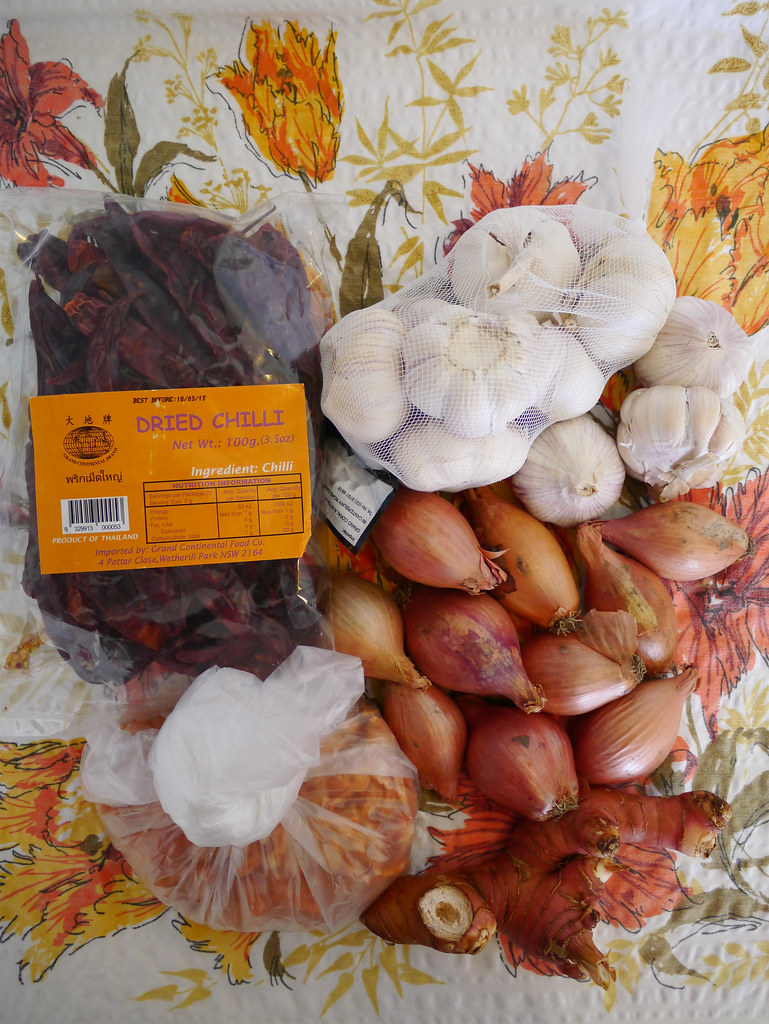


Place the dried shrimp in a bowl and add 1 litre of boiled water. Cover and let the shrimps soften/rehydrate for 1 hour. When the shrimps have rehydrated, strain and reserve the shrimp liquid/stock in a bowl. Let the shrimps drain and dry in a separate bowl with paper towels. Cover and put aside.

Peel the garlic cloves, cut off the roots if necessary, and then thinly slice.
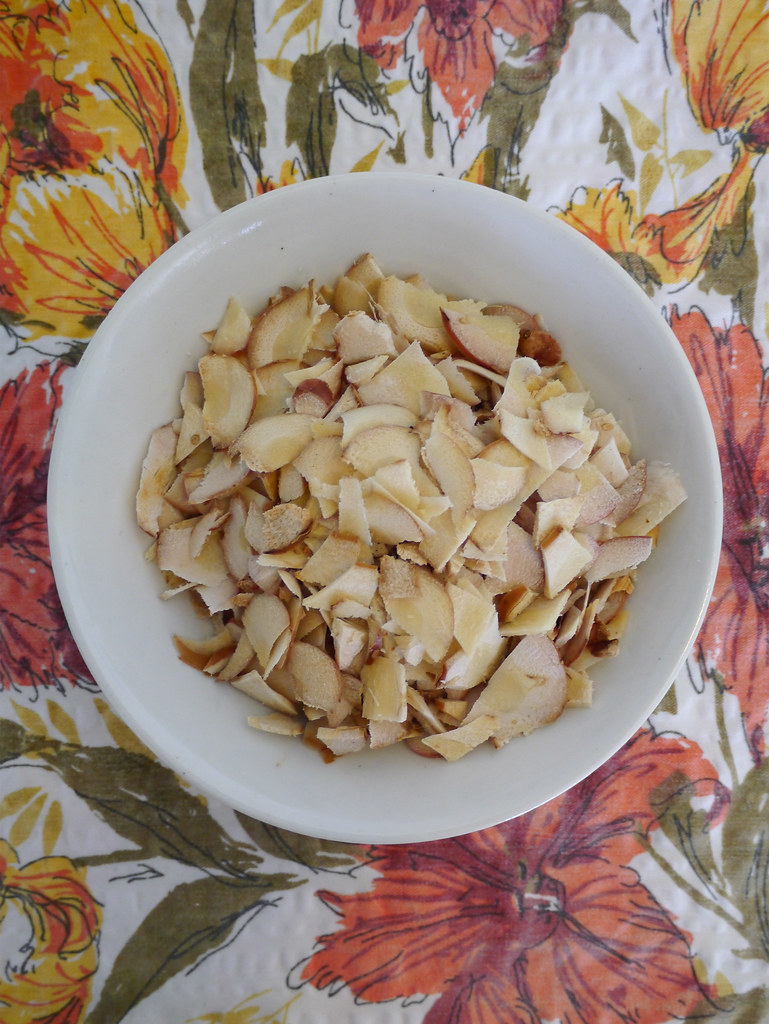
Wash the galangal, carefully cut into small segments, and then thinly slice.

Peel the French shallots, cut off the roots, and then thinly slice.

In a frying pan, add the vegetable oil and bring to medium heat. Add the sliced garlic and gently fry until they turn light golden brown and crisp up.

When they’re ready, strain and transfer to a bowl with paper towels to drain and dry.
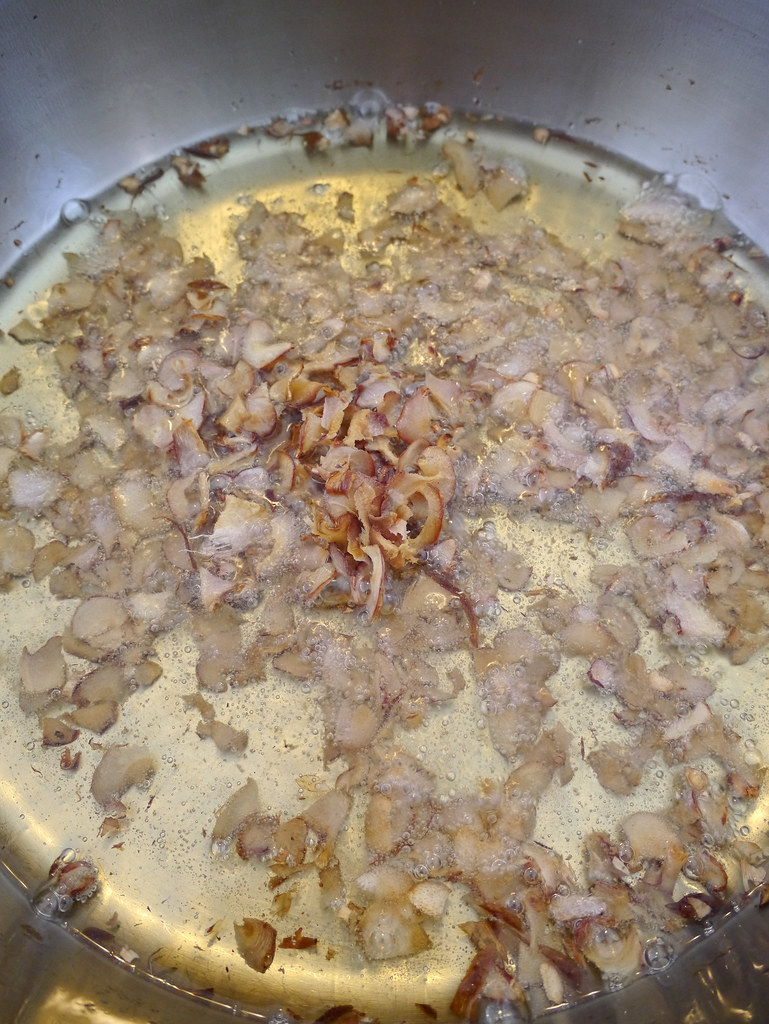
In the same oil, add the sliced galangal and gently fry until they turn light brown and crisp up.
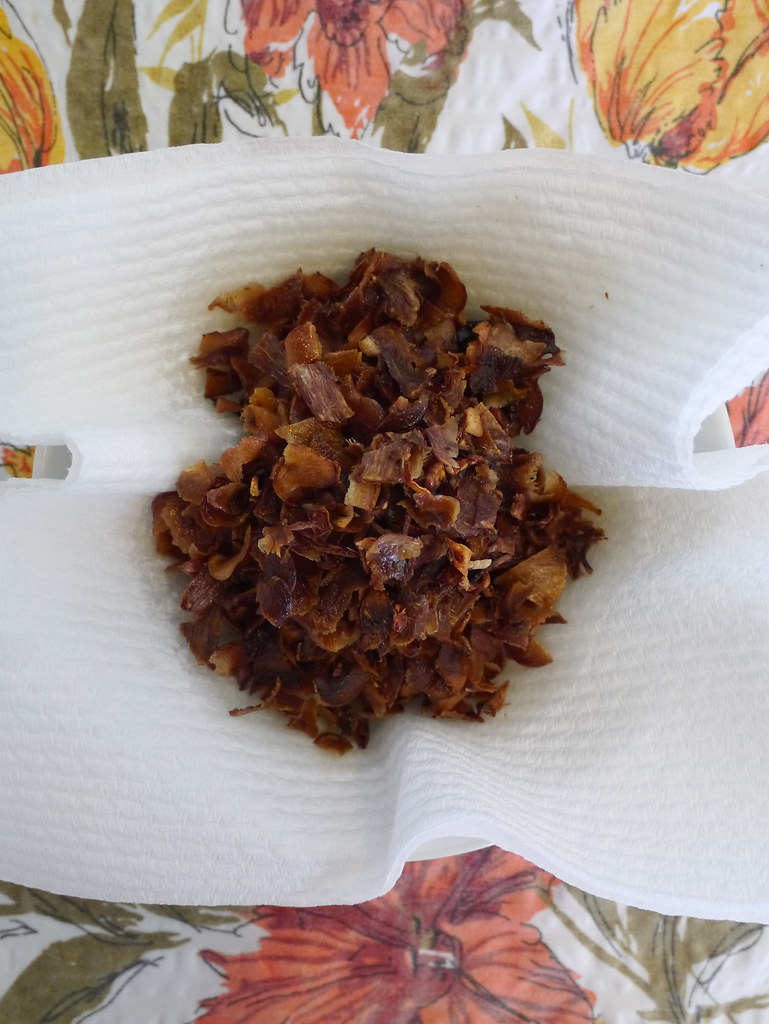
When they’re ready, strain and transfer to a bowl with paper towels to drain and dry.
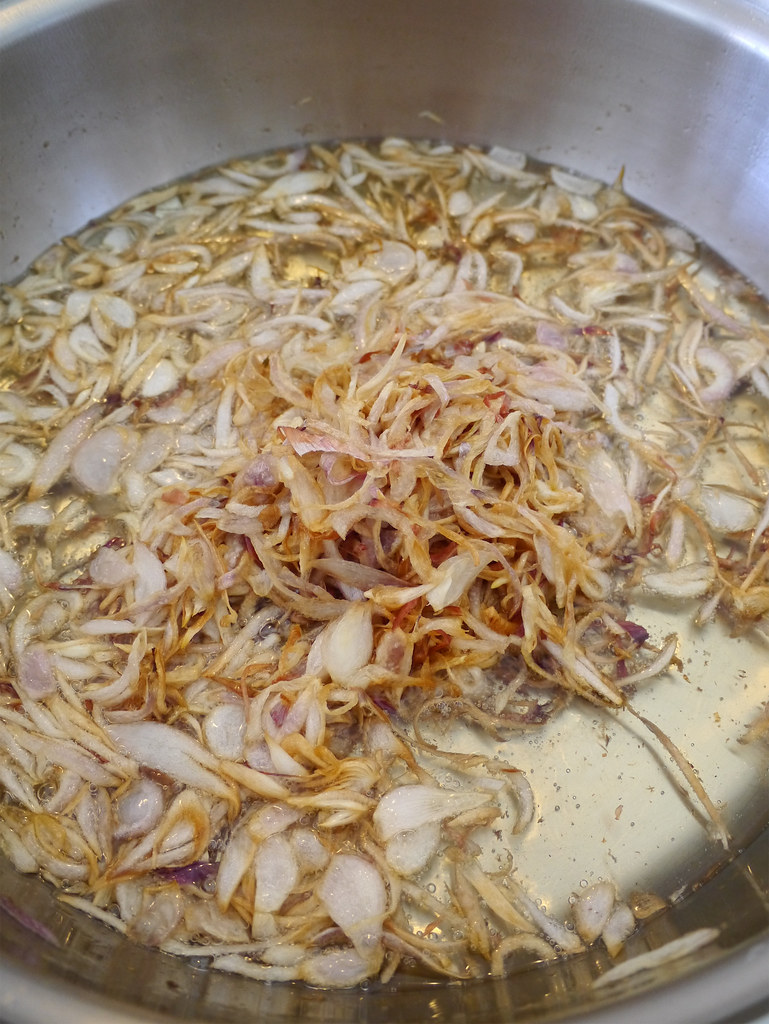
In the same oil, add the sliced French shallots and gently fry until they turn light brown and crisp up.
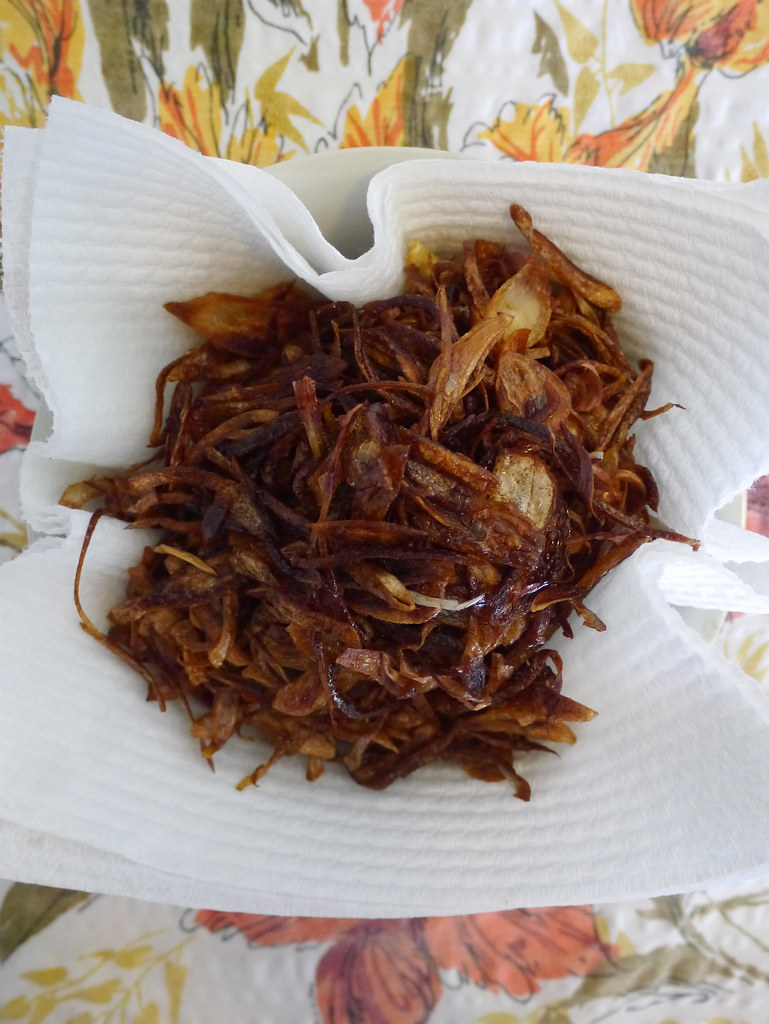
When they’re ready, strain and transfer to a bowl with paper towels to drain and dry.

In the same oil, add the dried red chilies and gently fry until they soften. Keep an eye on them because this will not take long and make sure the heat is low. Don’t let them burn or turn black whatever you do!
Note: For some reason, I had difficulty in getting the camera to focus correctly to take the photos of the dried red chilies being fried. As a result of my efforts to document this step for you, most (about 90%) of the dried chilies got over-fried/turned black, resulting in their waste and I having to improvise and continue the rest of this recipe by substituting the lost burnt chilies with fresh red bullet chilies and long green chili peppers instead. Initially, for the recipe, I wanted to use the whole 100 gram packet of the dried chili, plus about 20 fresh red bullet chilies. Instead, I resorted to using the chilies/quantities that I listed in the recipe below (30 dried red chilies, 20 fresh red bullet chiles and 20 long green chili peppers). If you want to, and if you’re extra vigilant when frying (because they will not take long at all), you can just use the whole 100 gram packet of dried red chilies (plus optional 20 fresh red bullet chilies) for this recipe. Good luck!
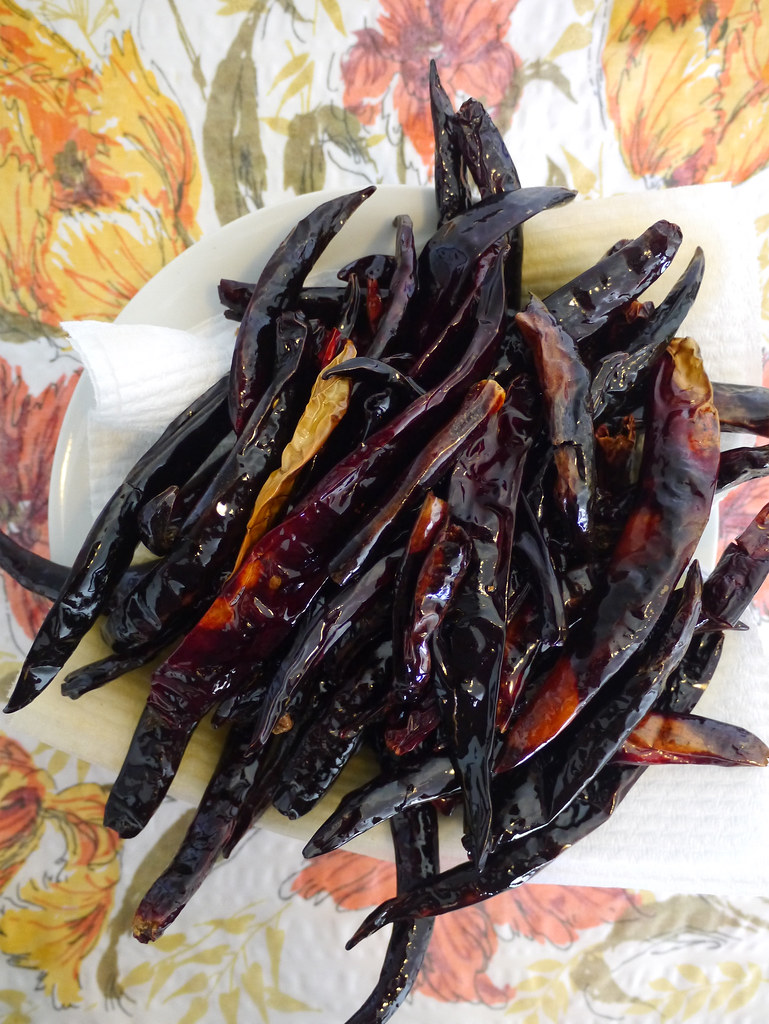
When they’re ready, strain and transfer to a bowl with paper towels to drain and dry.
As you can see, many of these are beautifully charcoal black/burnt. Not what I want for this recipe though. [Sigh]
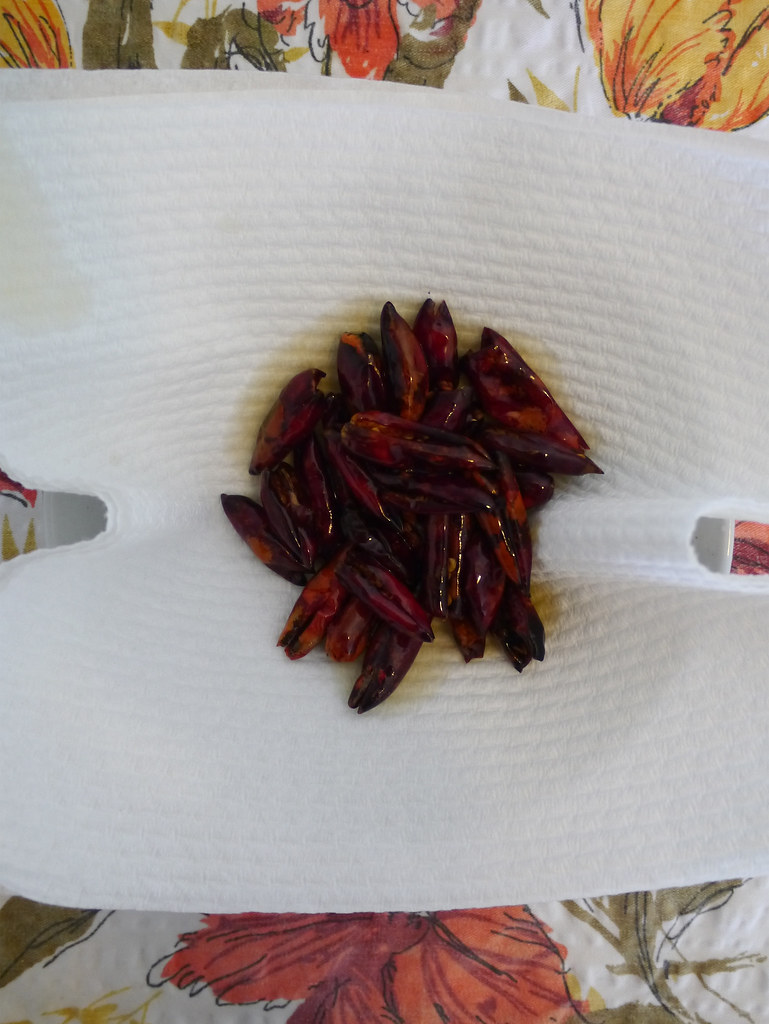
Cut a slit in the red bullet chilies and then gently fry until they turn light brown and crisp up. When they’re ready, strain and transfer to a bowl with paper towels to drain and dry.

Cut a slit in the long green chili peppers and then gently fry until they turn light brown and crisp up. When they’re ready, strain and transfer to a bowl with paper towels to drain and dry.

In the same oil, add the kaffir lime leaves and gently fry until they crisp up. When they’re ready, strain and transfer to a bowl with paper towels to drain and dry. Let the infused oil cool down completely and then pour it into a bowl or resealable glass jar. Reserve for later use!

In a large Lao mortar, add the fried chilies and pound to a fine consistency.
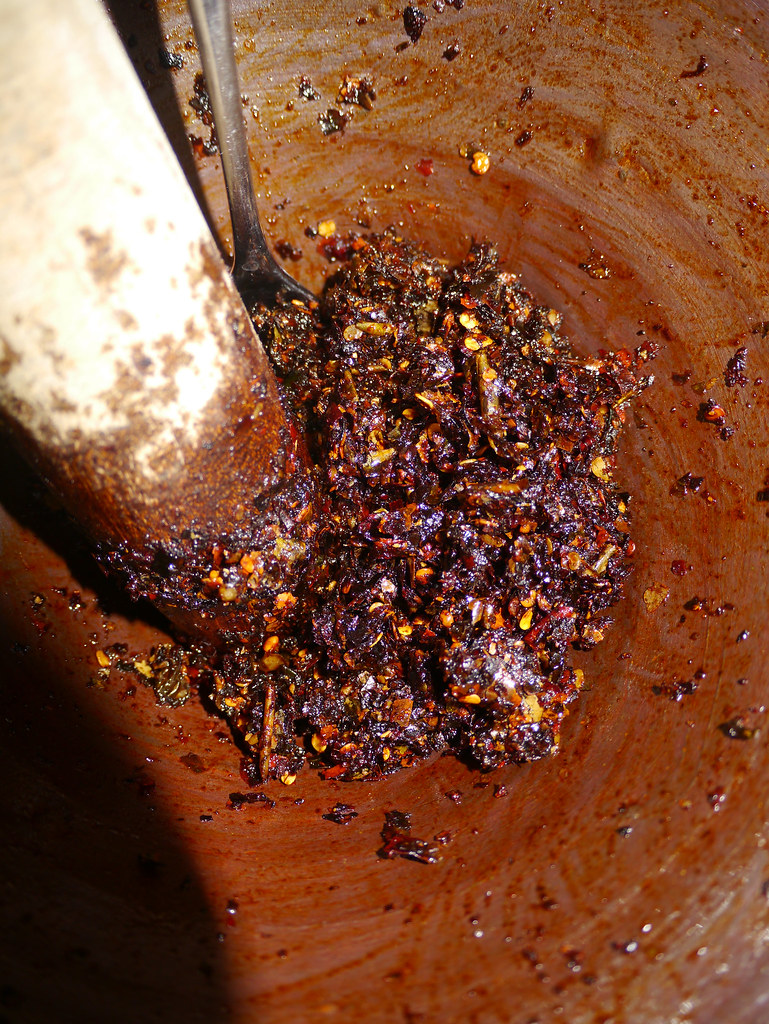
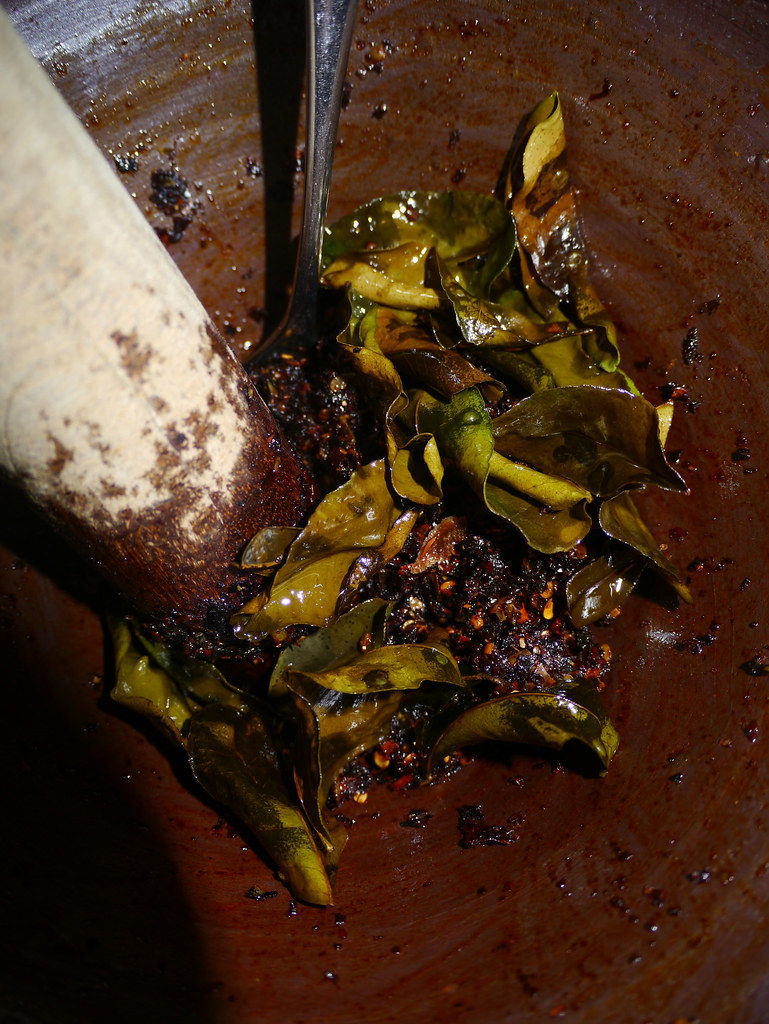
Add the fried kaffir lime leaves and continue to pound to a fine consistency.
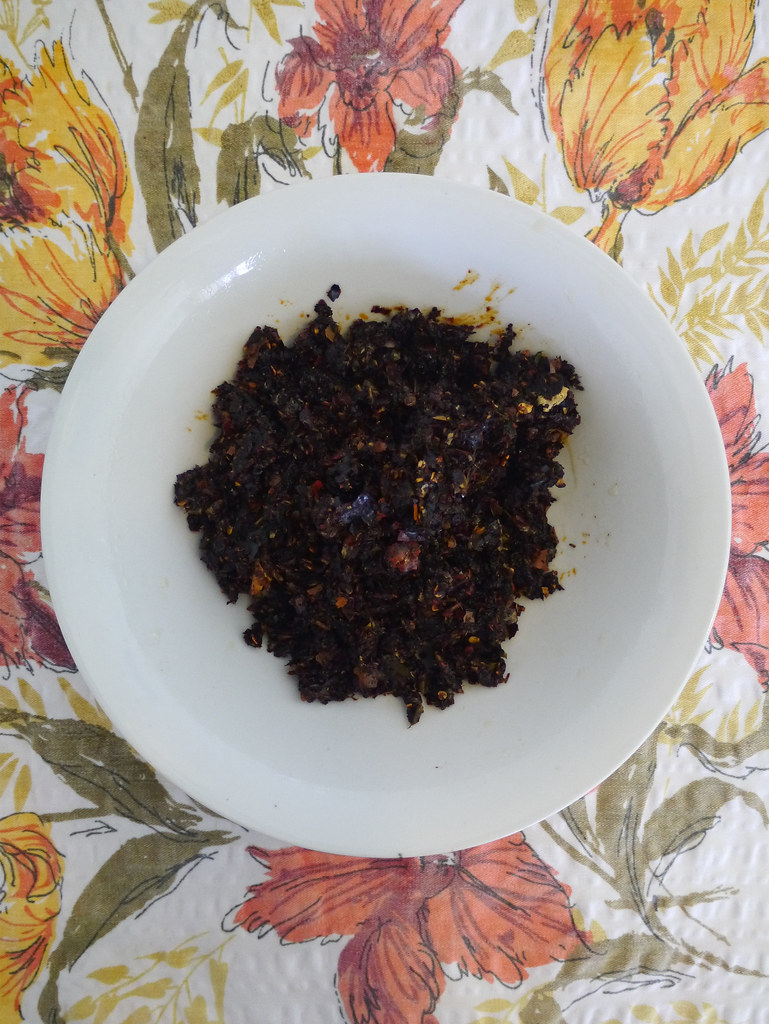
Transfer the mixture into a bowl and cover.
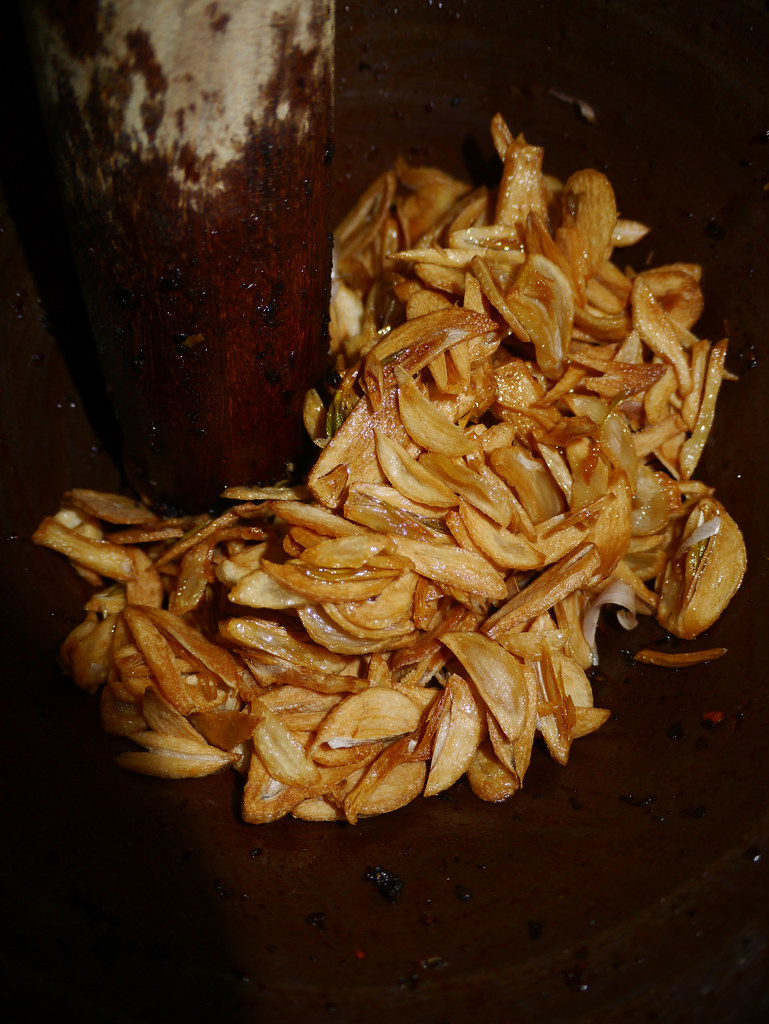
In the same mortar, add the fried garlic and pound to a fine consistency.
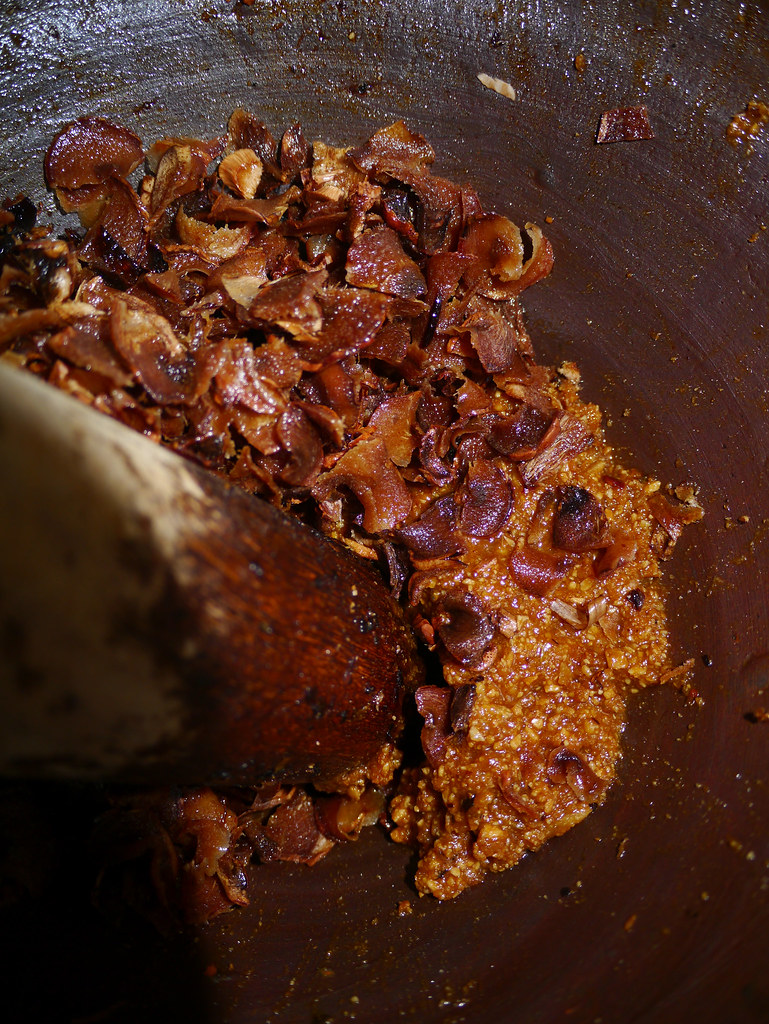
Add the fried galangal and continue to pound to a fine consistency.

Add the fried French shallots and continue to pound to a fine consistency.
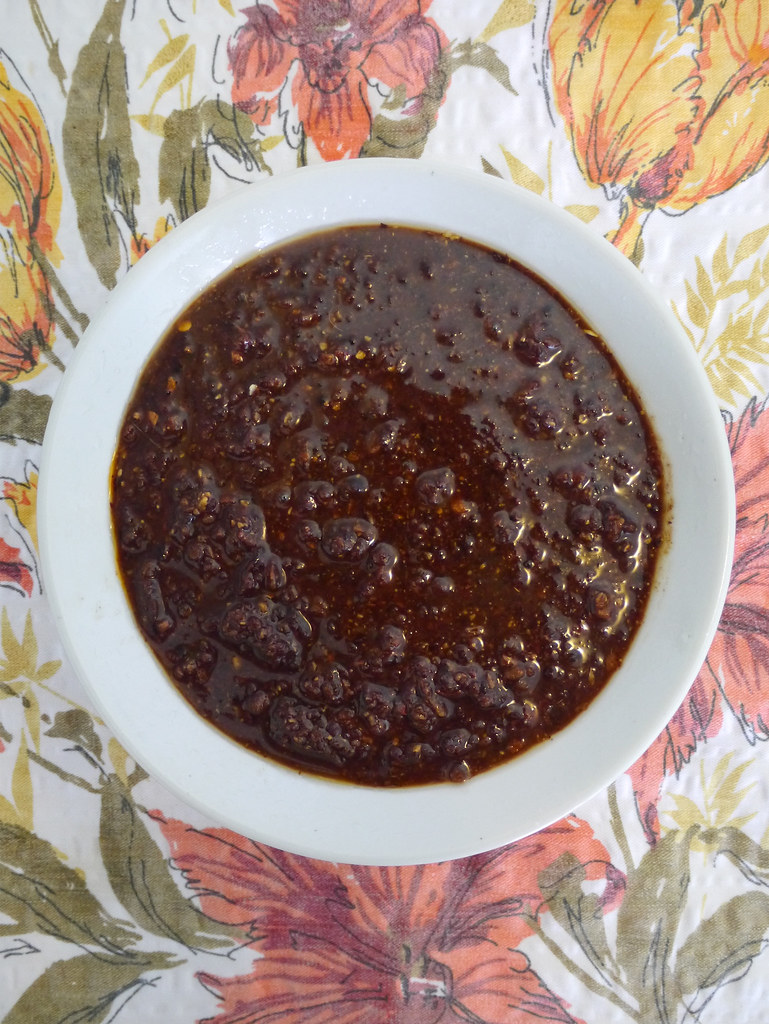
Transfer the mixture into a bowl and cover.
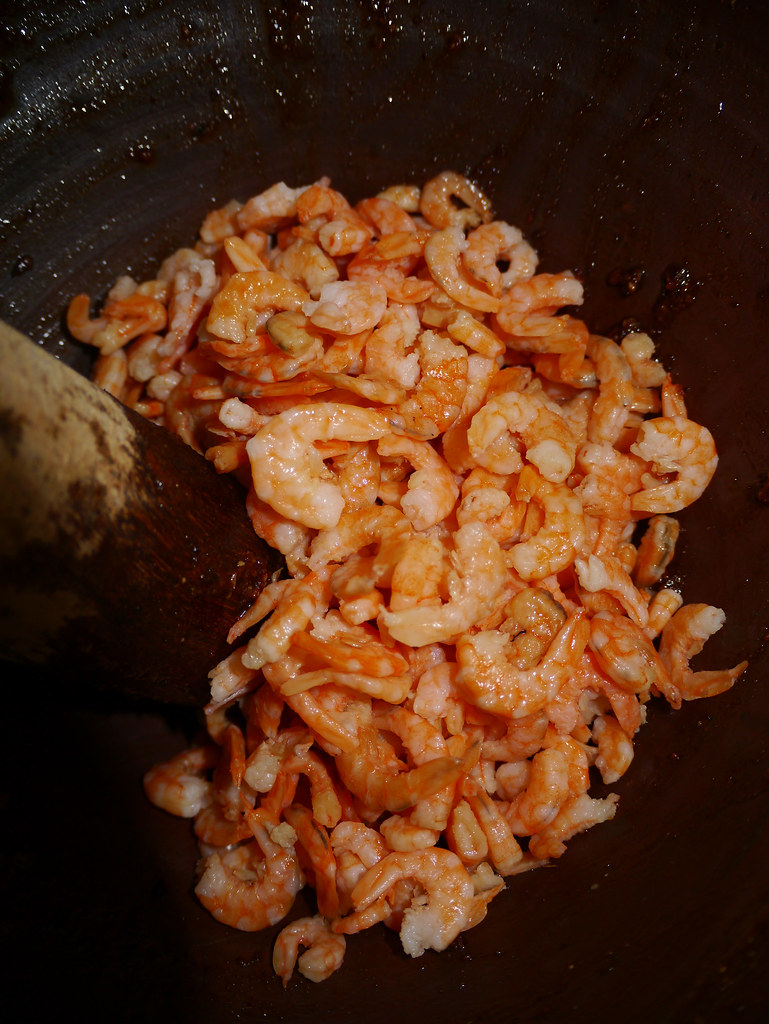
In the same mortar, add the rehydrated shrimp and pound to a fine consistency.



Add the fried chilies and kaffir lime leaves mixture, and the fried garlic, fried galangal and fried French shallots mixture and continue to pound and mix all of the ingredients well together.
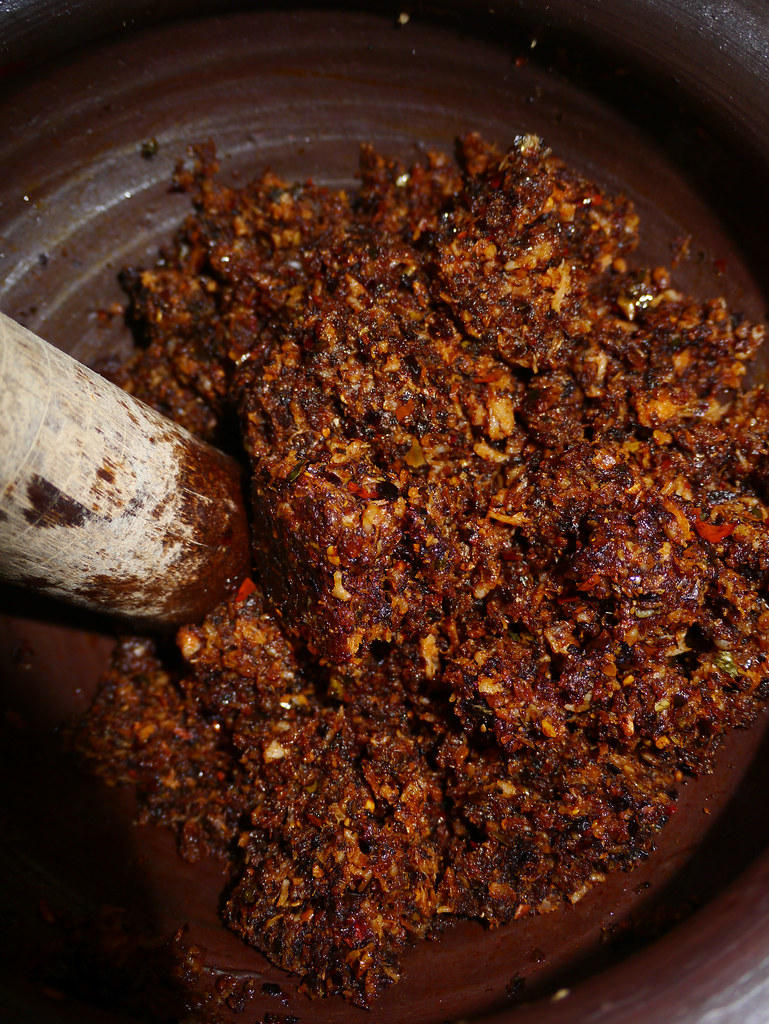

Add the raw sugar and sea salt and continue to pound and mix well together.
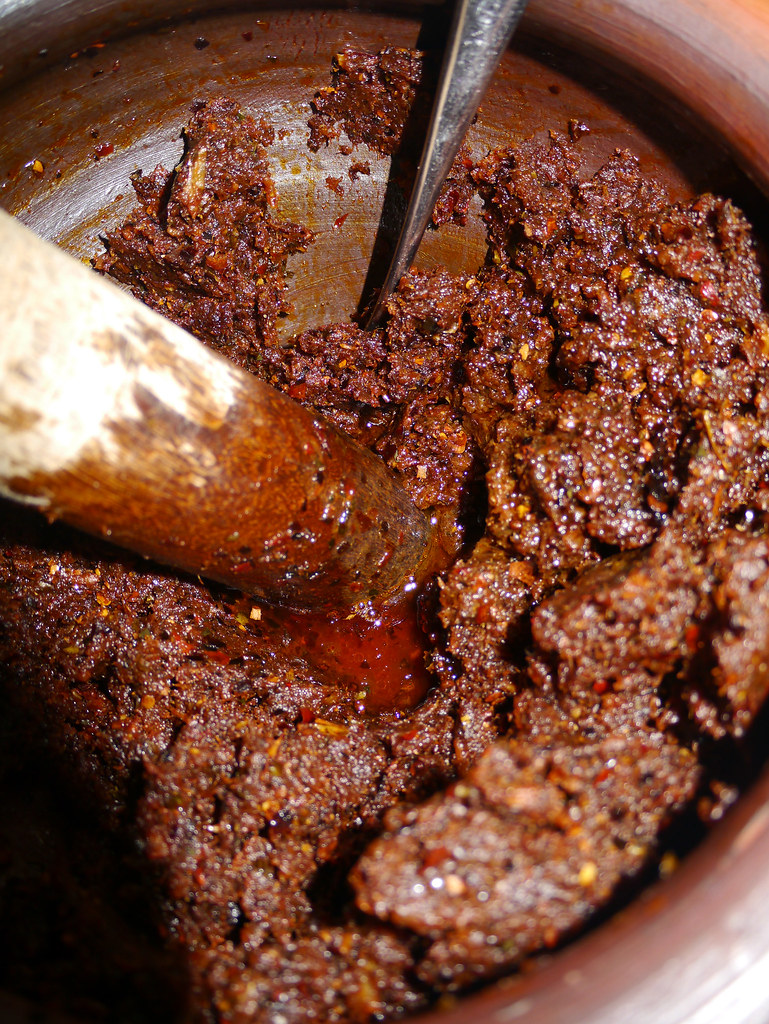
Add the fish sauce, fermented fish sauce, shrimp stock, infused oil and continue to pound and mix well together.
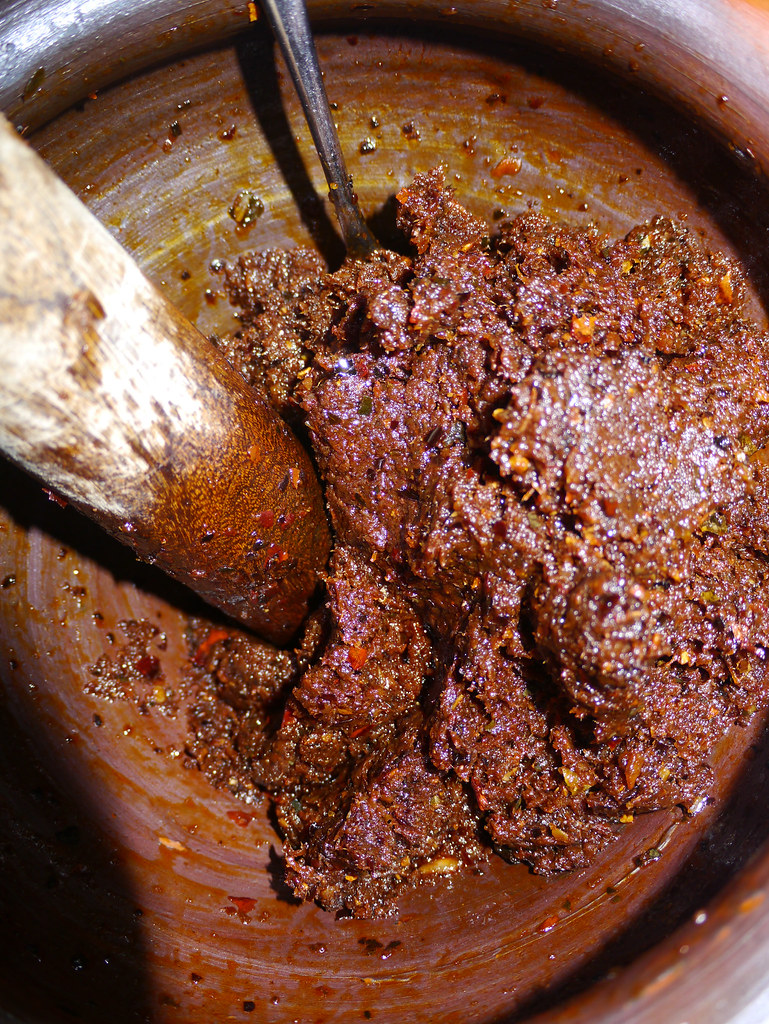
Taste and adjust the flavour to suit. What you’re aiming for is a delicious combination of sweet, spicy, salty, savoury and herbal. Jeow bong has got a distinctive sweet and spicy flavour to it!

When you’re happy with the flavour of the mixture, add the shredded pork skin and continue to pound and mix well together.
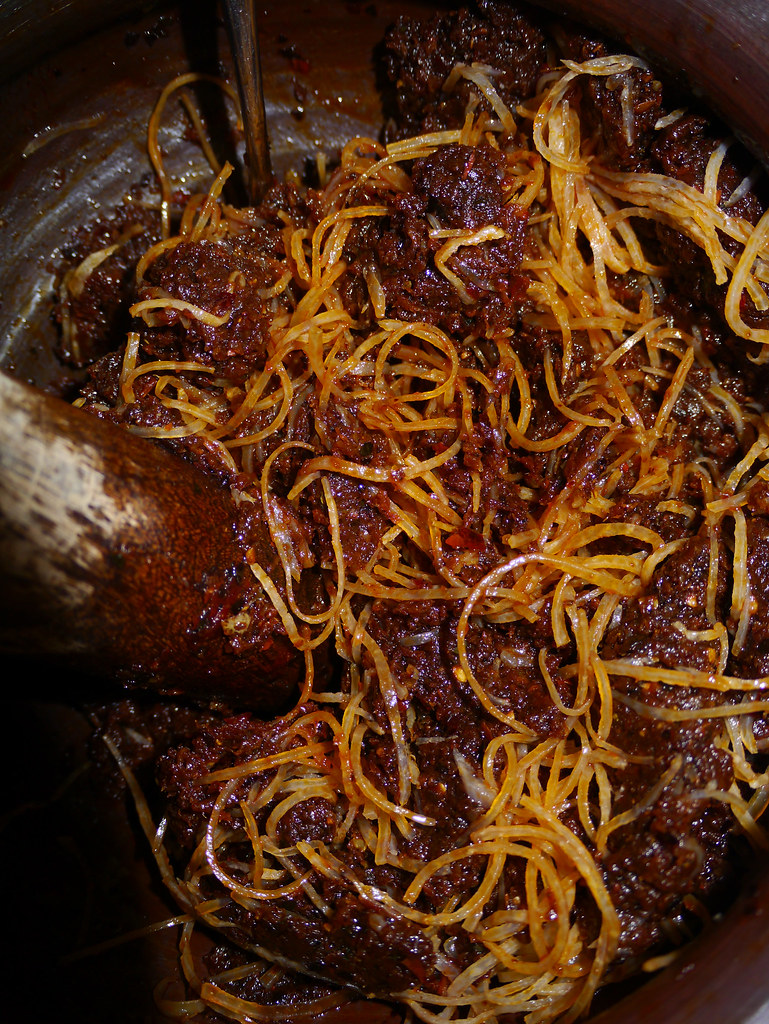

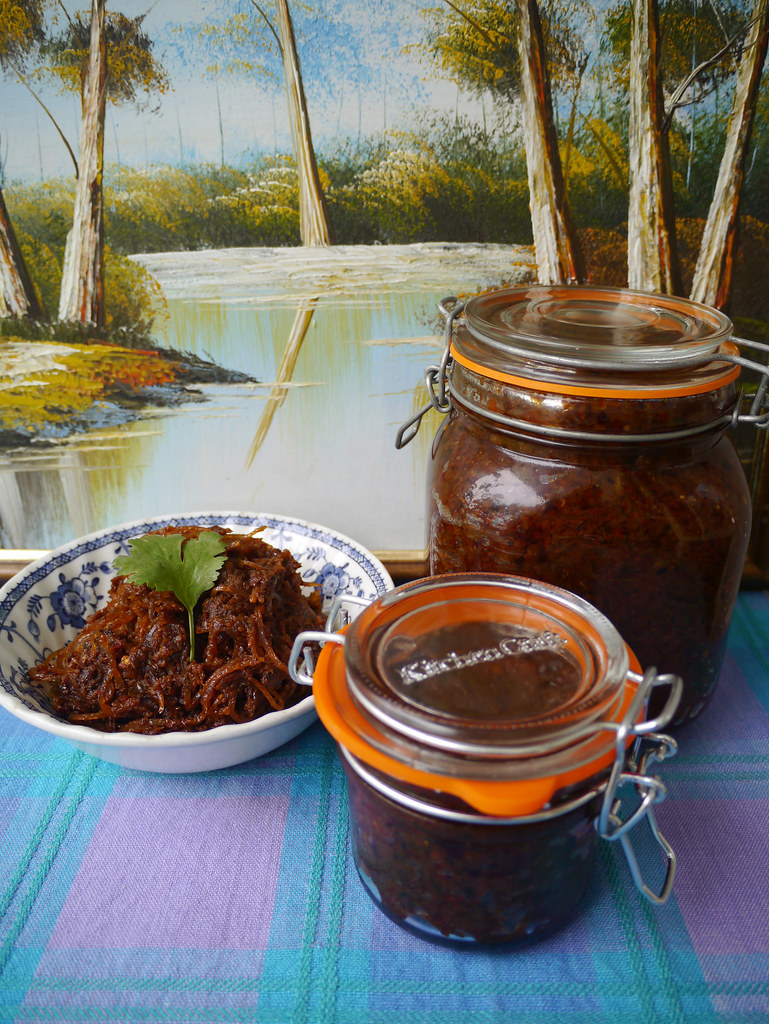
When done, transfer the required amount of jeow bong into a bowl and garnish with chopped coriander leaves. Serve with steaming hot sticky rice, your favourite cooked meats and steamed vegetables. Sern saab! bigsmile Transfer the rest of the jeow bong into a resealable glass jar and store in the fridge. Will last for a million years. Not quite, but it should last for a long time, perhaps about a month or so. Besides, it’s so delicious, you’ll definitely finish it before then. You can also enjoy it as a relish with steamed rice or as a condiment with your favourite dish!

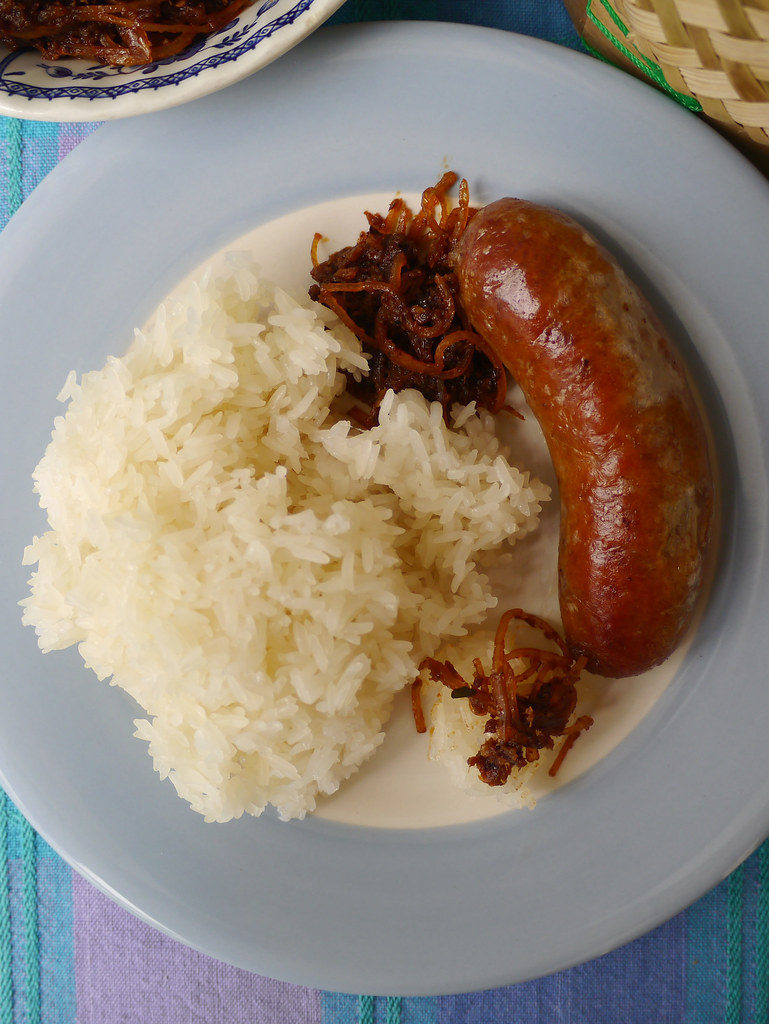
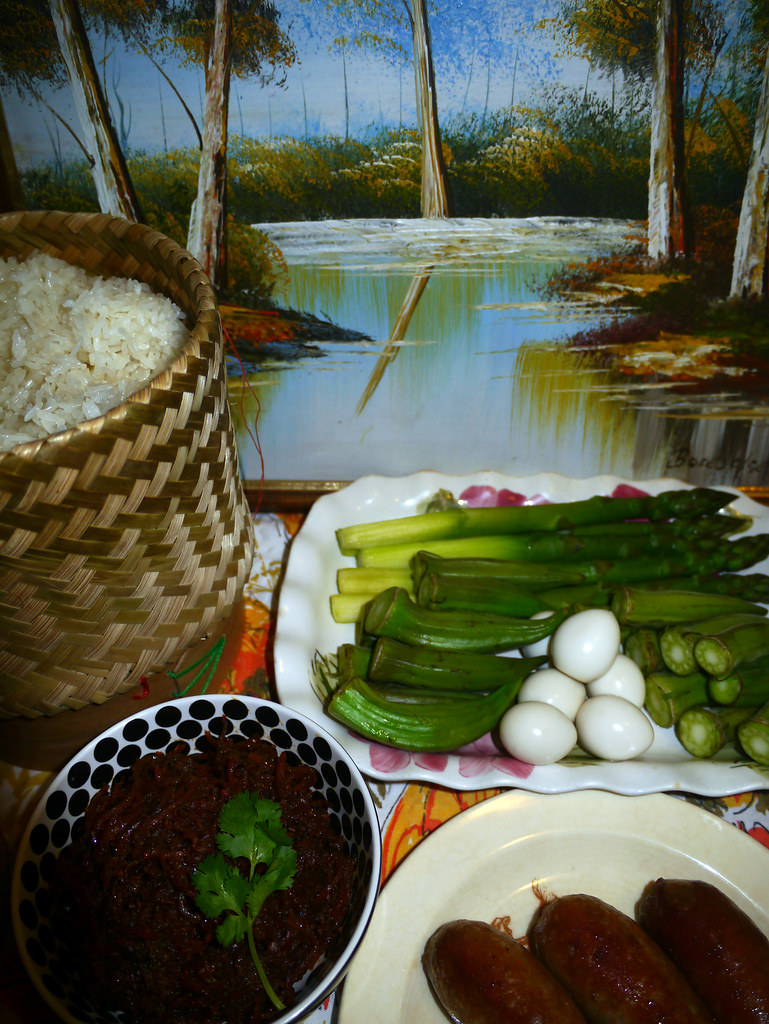
- 30 dried red chilies
- 30 fresh red bullet chilies
- 20 green (or red) long chili peppers
- 5 garlic heads
- 10 French shallots
- 15 cm piece of galangal
- 20 kaffir lime leaves
- 2 cups of dried shrimp
- 250 grams of shredded pork skin
- 3 TBSP of fish sauce
- 2 TBSP of fermented fish sauce
- 3 TBSP of raw sugar
- 2 tsp of sea salt
- 3 TBSP of shrimp stock (from the dried shrimp)
- 2 TBSP of infused oil (from frying)
- 750 ml of vegetable oil (for frying)
- 1 coriander (to garnish)
- Place the dried shrimp in a bowl and add 1 litre of boiled water. Cover and let the shrimps soften/rehydrate for 1 hour. When the shrimps have rehydrated, strain and reserve the shrimp liquid/stock in a bowl. Let the shrimps drain and dry in a separate bowl with paper towels. Cover and put aside.
- Peel the garlic cloves, cut off the roots if necessary, and then thinly slice.
- Wash the galangal, carefully cut into small segments, and then thinly slice.
- Peel the French shallots, cut off the roots, and then thinly slice.
- Wash and thinly slice the kaffir lime leaves. Put aside.
- In a frying pan, add the vegetable oil and bring to medium heat. Add the sliced garlic and gently fry until they turn light golden brown and crisp up. When they're ready, strain and transfer to a bowl with paper towels to drain and dry.
- In the same oil, add the sliced galangal and gently fry until they turn light brown and crisp up. When they're ready, strain and transfer to a bowl with paper towels to drain and dry.
- In the same oil, add the sliced French shallots and gently fry until they turn light brown and crisp up. When they're ready, strain and transfer to a bowl with paper towels to drain and dry.
- In the same oil, add the dried red chilies and gently fry until they soften. Keep an eye on them because this will not take long. Don't let them burn or turn black! When they're ready, strain and transfer to a bowl with paper towels to drain and dry.
- Cut a slit in the red bullet chilies and then gently fry until they turn light brown and crisp up. When they're ready, strain and transfer to a bowl with paper towels to drain and dry.
- Cut a slit in the green long chili peppers and then gently fry until they turn light brown and crisp up. When they're ready, strain and transfer to a bowl with paper towels to drain and dry.
- In the same oil, add the kaffir lime leaves and and gently fry until they crisp up. When they're ready, strain and transfer to a bowl with paper towels to drain and dry.
- Let the infused oil cool down completely and then pour it into a bowl or resealable glass jar. Reserve for later use!
- In a large Lao mortar, add the fried chilies and pound to a fine consistency. Add the fried kaffir lime leaves and continue to pound to a fine consistency. Transfer the mixture into a bowl and cover.
- In the same mortar, add the fried garlic and pound to a fine consistency. Add the fried galangal and continue to pound to a fine consistency. Add the fried French shallots and continue to pound to a fine consistency. Transfer the mixture into a bowl and cover.
- In the same mortar, add the rehydrated shrimp and pound to a fine consistency.
- Add the fried chilies and kaffir lime leaves mixture, and the fried garlic, fried galangal and fried French shallots mixture and continue to pound and mix all of the ingredients well together.
- Add the raw sugar and sea salt and continue to pound and mix well together.
- Add the fish sauce, fermented fish sauce, shrimp stock, infused oil and continue to pound and mix well together. Taste and adjust the flavour to suit. What you're aiming for is a delicious combination of sweet, spicy, salty, savoury and herbal. Jeow bong has got a distinctive sweet and spicy flavour to it!
- Add the shredded pork skin and continue to pound and mix well together.
- When done, transfer the required amount of jeow bong into a bowl and garnish with chopped coriander leaves. Serve with steaming hot sticky rice, your favourite cooked meats and steamed vegetables. Sern saab!bigsmile Transfer the rest of the jeow bong into a resealable glass jar and store in the fridge. Will last for a million years. Not quite, but it should last for a long time, perhaps about a month or so. Besides, it's so delicious, you'll definitely finish it before then. You can also enjoy it as a relish with steamed rice or as a condiment with your favourite dish!
[[1]]Reference: http://en.wikipedia.org/wiki/Luang_Prabang.[[1]]
[[2]]Referecne: http://www.seasite.niu.edu/lao/othertopics/foods/recipe.htm.[[2]]
[[3]]Image Source: Flickr. License: Creative Commons License.[[3]]
[[4]]Image Source: Wikimedia Commons. Date: 3 May 2011. License: Creative Commons Attribution-Share Alike 3.0 Unported.[[4]]
[[5]]Reference: http://www.seasite.niu.edu/lao/othertopics/foods/recipe5.htm.[[5]]